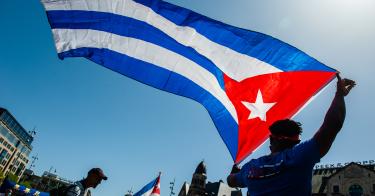One common trait among despots worldwide is their desire to control and restrict the flow of information among their citizens.
Today, the internet and other digital technology allow lightning-speed communication. Authoritarian regimes view that as a threat and seek to suppress it. Examples abound.
Last year, Russian President Vladimir Putin imposed an internet crackdown to help quash protests supportive of opposition leader Alexey Navalny. Belarusian President Alexander Lukashenko did the same to inhibit protests after his fraudulent election last summer. The Maduro regime in Venezuela played the same speech-repressing card in 2019 and 2020. Late last year, the Cuban regime disrupted social media and messaging platforms to take the wind from the sails of the San Isidro protests for artistic freedom.
We don't need to accept this repression as the new go-to status quo for authoritarian control.
>>> Why Russians Are Protesting the Arrest of Alexei Navalny
Now that thousands of Cubans have taken to the streets demanding liberty, the information chokehold has been reapplied. Sebastian Arcos, an associate director of the Cuban Research Institute at Florida International University, notes that the recent protests are "absolutely and definitely fueled by increased access to internet and smartphones in Cuba." He added, "One of the phrases that dissidents are using now in Cuba is 'we are connected.'" The regime moved quickly to restrict the protesters' ability to communicate by restricting access to the internet, social media, and messaging platforms. This makes it difficult for dissidents to organize and coordinate, thereby suppressing street action as well as verbal dissent.
Words of support and encouragement for the freedom-loving people of Cuba are well and good, but the United States can do more to help them.
For starters, Washington should take an active role in providing Cubans with the communication capabilities that have been stripped from them. Florida Gov. Ron DeSantis has written to President Joe Biden urging him to "assist in providing Internet access to the people of Cuba standing up against communist oppression." The U.S. has a rich history of leveraging telecommunications support to aid those resisting totalitarian regimes.
Former Secretary of Defense and CIA Director Bob Gates has discussed the nonmilitary, strategic importance of the now-abolished U.S. Information Agency, which worked to counter Soviet propaganda and promote the ideals of freedom. Tools such as Radio America and Radio Europe were successfully wielded during World War II and in Eastern Europe during the Cold War. We should build off the successful track records of our past for the modern world’s communications networks.
One way to do this is to harness capabilities that exist, such as the mothballed Alphabet "Project Loon" that received experimental licensing from the Federal Communications Commission in the aftermath of Hurricane Maria. Using stratospheric balloons flying up to 12 miles above Earth’s surface, Loon, in partnership with AT&T and T-Mobile, was able to deliver basic internet to more than 200,000 Puerto Ricans in 2017, when cell coverage on the island was for the most part destroyed by Hurricane Maria.
>>> Unprecedented Protests in Cuba Deserve America’s Support
In 2019, when Peru was hit with a massive earthquake, Loon technology was able to respond within 48 hours to the affected area with coverage. Flying at altitudes between 60,000 and 75,000 feet, well above commercial aircraft, each Loon balloon can deliver coverage over an area of 2,000 square miles. With administration support, collaboration, and indemnifications, technological capabilities such as this could restore the Cubans' ability to connect with the outside world and with each other. Microsoft, through its "Airband Initiative," is just one company that can use idle TV white space to deliver broadband internet coverage to hard-to-reach areas. And internet-less technologies such as Bridgefy can connect people via peer-to-peer mesh Bluetooth networks.
These are just a handful of examples of the technology options the U.S. should further explore—not only in helping the advance of freedom in Cuba but wherever autocratic regimes strive to restrict and censor their populace.
This piece originally appeared in the Washington Examiner



